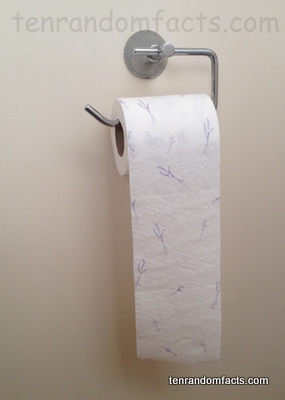Could you live without toilet paper?
- Toilet paper is an invention typically used to clean body waste off oneself, without using direct hand contact.
- Light and soft pulped paper is the typical material of toilet paper, and it may be layered one to three times, making it one to three ply paper.
- Toilet paper generally breaks down in sewage systems, making it moderately environmentally friendly, although it is not always the case with the product manufacturing process.
- ‘Toilet paper’ is also known as ‘toilet roll’, ‘dunny paper’, ‘bathroom tissue’, ’tissue’, and ‘bathroom paper’, and the product is commonly stored in a bathroom, on a rod attached to a wall or a floor base, as a dispenser.
- Generally, a sheet of toilet paper is almost square in shape and is usually around 10 centimetres (4 inches) across, or a little longer than it is wide.
- Paper, similar to toilet paper for wiping body waste, has been evident since 500 AD in Chinese culture.
- Although most often white in colour, toilet paper can depict a printed pattern, or it can be other bright colours, such as purple, blue or green; and it is usually purchased as a continuous length, rolled onto a cardboard tube that is sometimes scented.
- One of the costs of producing toilet paper around the world is the loss of 27,000 trees each day, the amount required to produce approximately 83 million rolls.
- Modern toilet paper is commonly accepted to have been invented in 1857 by Joseph Gayetty, from the United State’s New York, although the invention was largely ignored until the prominence of indoor toilets in the 1900s.
- Toilet paper substitutes that have been used in the past include corn cobs, snow, water, wool, vegetation, rags, lace, wood shavings, seashells and sponges, although in the early stages, the modern invention was not without its hazards, as splinters from the product were not uncommon.
Bibliography:
Huskey D, Toilet Paper wasn’t Commonly Used in the United States Until the Early 20th Century, 2012, Today I Found Out, http://www.todayifoundout.com/index.php/2013/07/toilet-paper-wasnt-commonly-used-in-the-united-states-until-the-early-20th-century/
McRobbie L, Toilet Paper History: How America Convinced the World to Wipe, 2009, Mental Floss, http://mentalfloss.com/article/23210/toilet-paper-history-how-america-convinced-world-wipe
Toilet Paper, 2015, Wikipedia, http://en.wikipedia.org/wiki/Toilet_paper








… and newspaper which is what we used when I was a child!!!